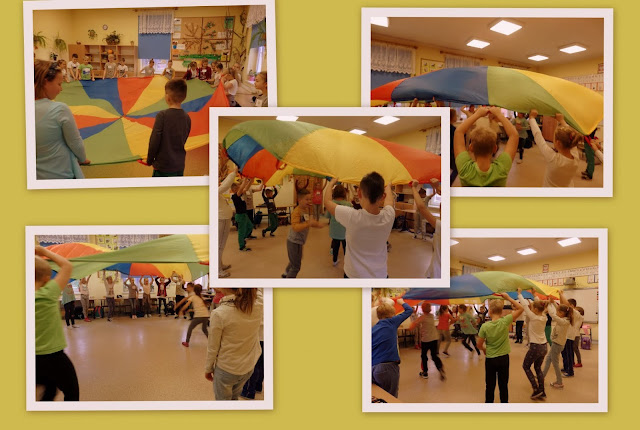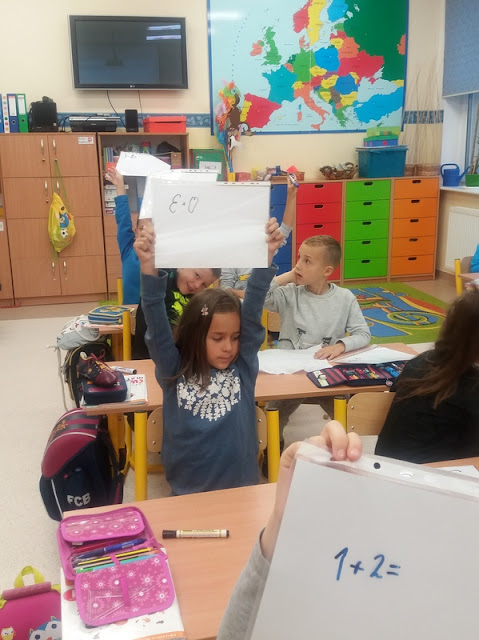Kostki na matematyce
Zabawa z kostkami
Celem tej zabawy jest ćwiczenie dodawania w zakresie
12. Uczniowie łączą się w pary, każda z
par otrzymuje 2 kostki oraz kartę pracy. Poza tym każdy z zespołu musi mieć
kredkę inną niż kolega z pary. Dzieci rzucają na przemian kostkami i zamalowują
pole z wynikiem, który uzyskały. Np. Jaś wyrzucił 5 i 4 więc mówi działanie:
5+4=9 i zamalowuje pole z tym numerem. Jeżeli uczeń uzyska wynik, który już
jest zamalowany, traci kolejkę. Wygrywa ta osoba, która ma więcej zamalowanych
pól.
Dice game.
The point
of this game is training to adding
numbers up to twelve. Students makes pairs and each pair takes 2 dice and a
list of things to do. Each student from team has to have different colour
pencil than person from pair. Children throw dice in turns and colour field
with number from dice. For example: John throws 5 and 4 so he is saying
equation: 5+4=9 and he is colouring field with this number. If student has the
sum which is already coloured he lost his turnieju. A person who has more
coloured fields than others is the winner.

Liczby - zabawa z chustą animacyjną
Dzieci naklejają sobie na bluzkę wylosowany numer, następnie stają wokół chusty którą każdy trzyma na ustalone hasło podnoszą chustę do góry, nauczyciel wywołuje kto ma przebiegać pod chustą, dzieci zamieniają się miejscami. Przykładowe polecenia: -wywoływanie poszczególnych liczb, -liczby parzyste -liczby nieparzyste, -liczby mające w swoim zapisie np. dwójkę (20, 2, 12 itd.), zero (10,20..) itp., - liczby większe od..., mniejsze od... -liczby dające wynik np.7 Uczniowie mogą zaproponować inne polecenia.
Fun game with an
educational scarf.
The Children have to draw (randomize) a number and put it on their T-shirts. Then all kids have to stay around the scarf and hold it. The teacher chooses one word (or command), and when he says this word loudly, all children have to lift the scarf. The teacher can say loudly numbers, for example 9, 2 or double figures or numbers divided by 2, or numbers higher than…, lower than... When the teacher says a special word or command, all kids who have a special number or who fit to a specific command have to run under the scarf and change their place in the circle. For example, a command may be: all the numbers which include 2 (e.g. 2, 12, 22, etc.). And as a result, every child who has 2 in his number, must swap their place with another child. Pupils can suggest their own ideas to this exercise.
Głuchy telefon
Klasę dzielimy na 6 rzędów zgodnie z miejscem siedzenia. Nauczyciel podaje po cichu pierwszym uczniom działanie (przygotowałam na kartce). Uczniowie odwracają się i podają drugim w rzędzie działania równoważne (u mnie dzieci piszą na folii pisakiem suchościeralnym), ci z kolei trzecim i tak do ostatnich. Ostatni pokazują swoje wyniki (mogą napisać na tablicy). Działania napisane na kartce ułatwiają odszukanie błędów w razie pomyłki.
Można bawić się przekazując sobie tylko różnice, iloczyny ...
The class is divided into 6 rows according to the place seating. The teacher gives the students quietly the first action (I prepared on a sheet). Students turn and give the second in a row action equivalent (in my children write on films pen suchościeralnym), who in turn the third, and so to the last. Last show their results (they can write on the board). Action written on a piece of help locate errors in the case of a mistake.
You can have fun passing himself only differences, intersections ...Wąż matematyczny
Kazdy uczeń bierze dwie części węża: początek i koniec. Odkrywa działanie matematyczne zapisane na kartce i podaje wynik, Za poprawną odpowiedź dokłada kolejną część węża. Można stosować do różnych działań matematycznych oraz różnicować stopień trudności.
Pomysł: Printoteka
Each student takes two hose: the beginning and the end. He discovers a mathematical operation recorded on the sheet and returns the result, for the correct answer makes another part of the hose. You can be used for various mathematical operations and differentiate degree of difficulty.
Matematyczne memory
Nauczyciel rozkłada przed uczniami 10 kartoników z działaniami (7x3, 5x6, 7x9, 6x8 itd.) oraz dziesięć kartoników z wynikami. Wszystkie kartoniki są odwrócone. Zadaniem dziecka jest znalezienie i połączenie działania z odpowiednim wynikiem.
Łańcuszek matematyczny
Wybrany uczeń wpisuje
dowolną liczbę w zakresie 100. Następne dziecko dopisuje znak matematyczny i pasującą do działania liczbę. Kolejne dziecko podaje wynik działania
matematycznego.
Chain mathematical
The selected student enters any number in the range of 100.
Next child writes mathematical sign and a matching number of activities.
Another child reports the result of the mathematical equation.
http://www.education.com/games/first-grade/
I found this page
with online maths games for all the units. Lets have a look.
Number’s
postcard
Pupils pick up the number from 0 to 99. They take a piece of paper (size A4), and have to fold this paper 4 times. In the middle they have to draw a little window for the number (name of the city from the postcard), they have to draw the lines in the place where the paper is folded. In the middle they have to write their number. In the other ‘windows’, according to the instruction, they have to:
Pupils pick up the number from 0 to 99. They take a piece of paper (size A4), and have to fold this paper 4 times. In the middle they have to draw a little window for the number (name of the city from the postcard), they have to draw the lines in the place where the paper is folded. In the middle they have to write their number. In the other ‘windows’, according to the instruction, they have to:
1)
draw a line for the decimals (tens) and a dot for the unity
2) try
to write your number like a decimal and a unity
3) try
to write in words this number.
4) write
an interesting operation, which the result is your number.
When
the posters are ready, we have to make a presentation of them. We can arrange
them in order: from the highest to the lowest or other way round, from the
lowest to the highest.
Widokówka liczby
Uczniowie losują liczbę od
0 do 99, biorą kartkę A4, którą składają na cztery części. Na środku rysują
okienko na nazwę liczby(nazwa miejscowości na widokówce), rysują kreski po
liniach złożenia. Wpisują na środku wylosowaną liczbę. W pozostałych okienkach
zgodnie z instrukcją np.: 1. Narysuj liczbę (kreska to dziesiątki ____________,
kropka to jedności) 2. Zapisz swoją liczbę jako dziesiątki i jedności, 3.
napisz liczbę słownie, 4. Napisz ciekawe działanie, którego wynikiem jest twoja
liczba. Po wykonaniu widokówek, następuje prezentacja. Można dodatkowo ułożyć
je w kolejności malejącej lub rosnącej.
Basic math and number concepts
Basic math and number concepts utilized in a preschool or kindergarten
classroom set the foundation for learning more advanced math concepts.
Early exposure to math and number activities will promote your students
comfort with these skills. Also, additional opportunities to practice
these skills will increase your child’s confidence when working with
math and number concepts and will lead him to believe he is “good at
math.” If your student does not become comfortable with math and number
concepts at a young age, he will lack confidence in his abilities and
may become hesitant as more advanced math concepts are introduced.The
first step in Math and Number Awareness is learning what the 10 numerals
(0 through 9) look like Children in the classroom may be asked to “Cut
out five circles,” “Pick three friends,” or “Ask one question,” for
example. Understanding the significance of numerals will directly
contribute to a child’s success in the classroom.“Counting on” allows a
child to continue counting objects added to a previously counted group
without recounting the entire groupCounting on is an important skill
because it is time-consuming and impractical to recount a group of items
each time additional pieces are added.
Subskrybuj:
Komentarze (Atom)


















































